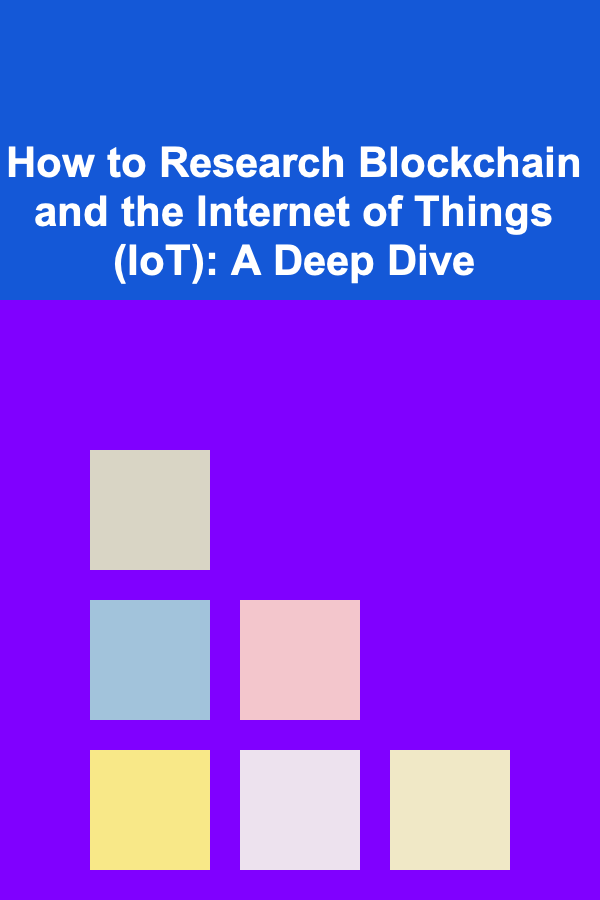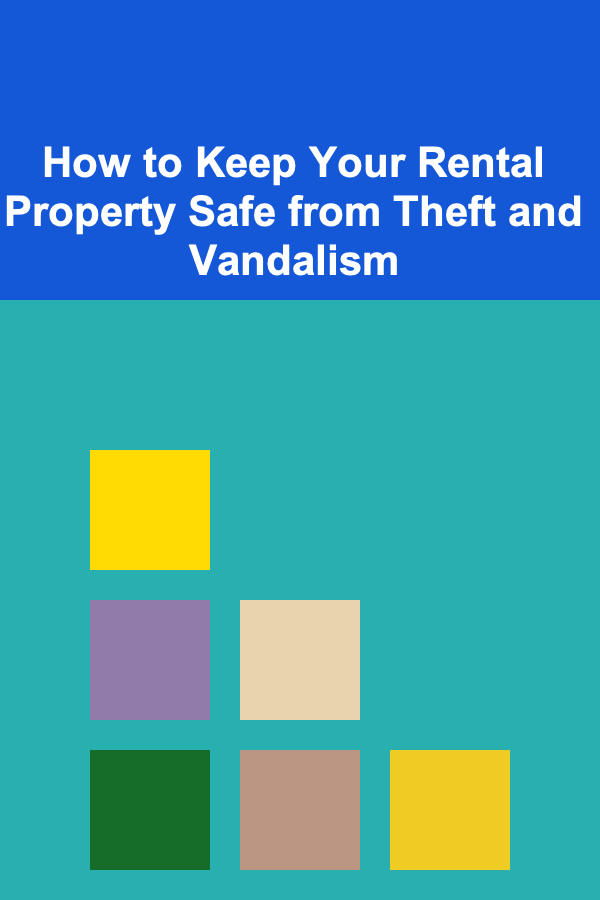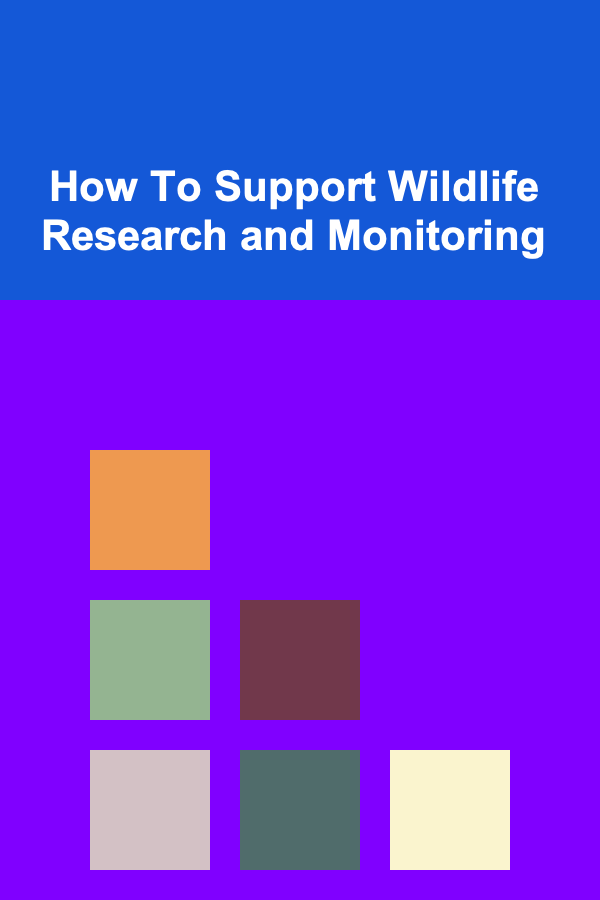
How to Research Blockchain and the Internet of Things (IoT): A Deep Dive
ebook include PDF & Audio bundle (Micro Guide)
$12.99$6.99
Limited Time Offer! Order within the next:

The convergence of Blockchain and the Internet of Things (IoT) presents a fascinating and complex landscape for research. These two technologies, while distinct in their origins and functionalities, offer synergistic potential to address critical challenges in data security, scalability, and trust within the connected device ecosystem. However, navigating the nuances of this intersection requires a structured approach, careful consideration of the underlying technologies, and a thorough understanding of the potential applications and limitations. This article provides a comprehensive guide to researching Blockchain and IoT, covering key aspects from foundational understanding to advanced exploration.
I. Laying the Groundwork: Understanding the Core Technologies
Before delving into the specifics of Blockchain-IoT integration, it's essential to have a solid grasp of each technology individually. This involves understanding their core principles, functionalities, architectures, and limitations.
A. Deep Dive into Blockchain Technology
Blockchain, at its core, is a distributed, immutable ledger technology. It records transactions across a network of computers, making it difficult to alter or censor data. Key concepts to understand include:
- Decentralization: Blockchain eliminates the need for a central authority, distributing trust across the network. This resilience is achieved by replicating the entire ledger across multiple nodes, making the system less vulnerable to single points of failure.
- Immutability: Once a transaction is recorded on the blockchain, it cannot be altered or deleted. This property is enforced through cryptographic hashing and a consensus mechanism, ensuring data integrity and auditability. Each block contains a hash of the previous block, creating a chain of interconnected blocks.
- Cryptography: Blockchain relies heavily on cryptographic techniques such as hashing and digital signatures to secure transactions and ensure authenticity. Hashing algorithms provide a one-way function, while digital signatures verify the sender's identity.
- Consensus Mechanisms: Different blockchains employ various consensus mechanisms (e.g., Proof-of-Work, Proof-of-Stake, Delegated Proof-of-Stake, Byzantine Fault Tolerance) to ensure agreement among network participants on the validity of transactions. Understanding the strengths and weaknesses of each consensus mechanism is crucial. For example, Proof-of-Work is highly secure but energy-intensive, while Proof-of-Stake is more energy-efficient but potentially less resistant to certain types of attacks.
- Smart Contracts: Self-executing contracts written in code and stored on the blockchain. They automatically enforce the terms of an agreement when specific conditions are met. Smart contracts can automate complex processes and eliminate the need for intermediaries. Languages like Solidity are commonly used for writing smart contracts on the Ethereum blockchain.
- Different Blockchain Types: It is important to distinguish between public (permissionless) blockchains like Bitcoin and Ethereum, and private (permissioned) blockchains like Hyperledger Fabric and Corda. Public blockchains are open to anyone, while private blockchains restrict access to authorized participants. Consortium blockchains are a hybrid approach, where multiple organizations collectively govern the network. The choice of blockchain type depends on the specific application requirements and the level of control desired.
Research Resources for Blockchain:
- Academic Papers: Explore databases like IEEE Xplore, ACM Digital Library, and Google Scholar for peer-reviewed research on blockchain technology. Search for keywords like "blockchain consensus mechanisms," "blockchain security," "smart contracts," and "distributed ledger technology."
- Industry Reports: Consult reports from reputable consulting firms like Gartner, McKinsey, and Deloitte for insights into blockchain trends, adoption rates, and market forecasts. These reports often provide valuable perspectives on the business implications of blockchain technology.
- Blockchain Projects: Study the documentation and code of popular blockchain projects like Bitcoin, Ethereum, Hyperledger Fabric, and Corda. Understanding how these projects are implemented can provide valuable practical knowledge. GitHub is a great resource for exploring open-source blockchain projects.
- Online Courses: Enroll in online courses on platforms like Coursera, edX, and Udemy to gain a structured understanding of blockchain technology from experts in the field.
- Whitepapers: Read the whitepapers of various blockchain projects to understand their underlying principles and technical specifications. The Bitcoin whitepaper by Satoshi Nakamoto is a foundational document in the blockchain space.
B. Exploring the Realm of the Internet of Things (IoT)
IoT refers to the network of physical devices embedded with sensors, software, and other technologies to connect and exchange data with other devices and systems over the internet. Key concepts to understand include:
- IoT Architecture: Typically involves multiple layers, including devices, gateways, network infrastructure, and cloud platforms. Understanding the role of each layer is crucial for designing and deploying IoT solutions. The architecture can vary depending on the application, but it generally involves data collection, processing, transmission, and analysis.
- IoT Protocols: A wide range of communication protocols are used in IoT, including MQTT, CoAP, HTTP, Bluetooth, Zigbee, and LoRaWAN. The choice of protocol depends on factors like bandwidth requirements, power consumption, and range. MQTT is commonly used for lightweight messaging, while LoRaWAN is suitable for long-range, low-power applications.
- IoT Security: Security is a major concern in IoT due to the large number of connected devices and the potential for vulnerabilities. Securing IoT devices requires addressing issues like authentication, authorization, data encryption, and firmware updates. IoT devices are often resource-constrained, making it challenging to implement robust security measures.
- IoT Data Management: IoT devices generate vast amounts of data that need to be processed, stored, and analyzed. Data management strategies include edge computing, cloud computing, and data analytics platforms. Edge computing involves processing data closer to the source, reducing latency and bandwidth requirements.
- IoT Platforms: Provide a comprehensive set of tools and services for building and managing IoT applications. Examples include AWS IoT Core, Azure IoT Hub, and Google Cloud IoT Platform. These platforms offer features like device management, data ingestion, analytics, and security.
- Edge Computing: Processing data closer to the source (the IoT device) rather than sending it to a centralized cloud. This reduces latency, bandwidth consumption, and improves real-time response.
Research Resources for IoT:
- Industry Associations: Organizations like the IoT Consortium and the Industrial Internet Consortium provide valuable resources and best practices for IoT. These organizations also publish whitepapers, case studies, and other materials.
- Academic Journals: Journals like the IEEE Internet of Things Journal and the ACM Transactions on Internet of Things publish cutting-edge research on IoT topics.
- IoT Platforms Documentation: Explore the documentation of popular IoT platforms like AWS IoT Core, Azure IoT Hub, and Google Cloud IoT Platform to understand their capabilities and limitations.
- IoT Security Standards: Familiarize yourself with IoT security standards and guidelines from organizations like NIST, OWASP, and ETSI. These standards provide recommendations for securing IoT devices and systems.
- Open-Source IoT Projects: Investigate open-source IoT platforms and frameworks like Eclipse IoT, ThingsBoard, and Kaa. These projects provide practical examples of IoT implementation.
II. Exploring the Convergence: Blockchain and IoT Integration
Once you have a solid understanding of both Blockchain and IoT, you can begin to explore how they can be integrated to create innovative solutions. This involves understanding the potential benefits, challenges, and architectural considerations of combining these technologies.
A. Potential Benefits of Blockchain-IoT Integration
The integration of Blockchain and IoT offers numerous advantages:
- Enhanced Security: Blockchain's immutability and cryptographic security can protect IoT data from tampering and unauthorized access. This is particularly important in applications where data integrity is critical, such as supply chain management and healthcare.
- Improved Data Integrity: Blockchain ensures the authenticity and provenance of IoT data, making it easier to verify the accuracy of information collected from sensors and devices. This can help to build trust in IoT systems and improve decision-making.
- Increased Transparency: Blockchain provides a transparent and auditable record of all transactions and data exchanges in the IoT ecosystem. This can help to improve accountability and traceability.
- Reduced Costs: Blockchain can eliminate the need for intermediaries and streamline processes, reducing costs associated with data management, authentication, and security.
- Automated Processes: Smart contracts can automate complex processes in the IoT ecosystem, such as device provisioning, data sharing, and payment processing.
- Enhanced Trust: By providing a tamper-proof record of interactions, blockchain enhances trust between parties in IoT networks, especially in scenarios involving multiple stakeholders.
- Improved Scalability: Certain blockchain architectures can enhance the scalability of IoT systems by distributing data storage and processing across multiple nodes.
B. Key Challenges of Blockchain-IoT Integration
Despite the potential benefits, integrating Blockchain and IoT also presents several challenges:
- Scalability: Blockchain's transaction processing capacity may not be sufficient to handle the high volume of data generated by IoT devices. This is particularly true for public blockchains like Bitcoin and Ethereum. Solutions include using private or consortium blockchains, implementing layer-2 scaling solutions, or using sharding techniques.
- Cost: Blockchain transactions can be costly, especially on public blockchains with high gas fees. This can be a barrier to adoption for low-value IoT applications. Consider using energy-efficient consensus mechanisms and optimizing smart contract code to reduce transaction costs.
- Latency: Blockchain transactions can take time to confirm, which may not be acceptable for real-time IoT applications. Explore alternative consensus mechanisms or off-chain solutions to reduce latency.
- Complexity: Integrating Blockchain and IoT requires specialized knowledge and expertise. Developing and deploying blockchain-based IoT solutions can be complex and time-consuming. Leverage existing tools and frameworks to simplify the integration process.
- Data Privacy: Storing sensitive IoT data on a public blockchain can raise privacy concerns. Implement data encryption and access control mechanisms to protect sensitive information. Consider using privacy-preserving technologies like zero-knowledge proofs.
- Interoperability: Different blockchain platforms and IoT devices may not be interoperable, making it difficult to integrate them. Develop interoperability standards and protocols to facilitate seamless communication between different systems.
- Resource Constraints: IoT devices often have limited processing power, memory, and battery life. Running blockchain applications on these devices can be challenging. Use lightweight blockchain implementations and optimize code for resource-constrained environments.
- Regulation: The regulatory landscape surrounding blockchain and IoT is still evolving. Businesses must be aware of and compliant with applicable regulations.
C. Architectures for Blockchain-IoT Integration
Several architectural patterns can be used to integrate Blockchain and IoT:
- Blockchain as a Data Ledger: IoT devices send data to the blockchain for storage and verification. This architecture is suitable for applications where data integrity and auditability are critical.
- Blockchain for Device Identity and Access Management: Blockchain can be used to manage device identities and control access to IoT resources. This can improve security and prevent unauthorized access.
- Blockchain for Smart Contracts and Automation: Smart contracts can automate complex processes in the IoT ecosystem, such as device provisioning, data sharing, and payment processing.
- Edge Computing with Blockchain: Blockchain nodes can be deployed at the edge of the network to process data locally and reduce latency. This architecture is suitable for real-time IoT applications.
- Hybrid Architectures: Combine different architectural patterns to create a customized solution that meets the specific requirements of the application. For example, you can use a private blockchain for internal data management and a public blockchain for external data sharing.
When researching architectures, consider the following questions:
- Where will data be stored (on-chain, off-chain, hybrid)?
- How will devices authenticate with the blockchain network?
- What type of blockchain is most suitable (public, private, consortium)?
- What consensus mechanism is appropriate for the application's requirements?
III. Research Methodologies for Blockchain and IoT
Conducting effective research in this interdisciplinary field requires a combination of theoretical understanding and practical experimentation. Here's a breakdown of useful methodologies:
A. Literature Review and Systematic Mapping
Begin with a comprehensive review of existing literature. This involves identifying relevant research papers, articles, reports, and whitepapers related to Blockchain, IoT, and their integration. A systematic mapping approach can help you organize and categorize the literature to identify research gaps and opportunities.
- Database Exploration: Utilize academic databases like IEEE Xplore, ACM Digital Library, ScienceDirect, and Google Scholar to search for relevant publications. Use keywords such as "Blockchain IoT integration," "IoT security blockchain," "distributed ledger IoT," "smart contracts IoT," and "IoT data integrity blockchain."
- Citation Analysis: Analyze the citation networks of key publications to identify influential papers and researchers in the field. This can help you to uncover related research that you might have missed.
- Systematic Mapping: Develop a systematic mapping protocol to categorize and classify the literature based on different criteria, such as application domain, architecture, consensus mechanism, and security considerations. This can help you to identify research trends and gaps.
- Grey Literature Review: Include non-academic sources such as industry reports, whitepapers, blog posts, and forum discussions in your literature review. This can provide valuable insights into real-world applications and challenges.
B. Case Study Analysis
Examine real-world case studies of Blockchain-IoT implementations. This provides valuable insights into the practical applications, benefits, and challenges of this technology. Analyze existing deployments in various industries like supply chain, healthcare, agriculture, and smart cities.
- Identify Case Studies: Search for case studies on industry websites, news articles, and research reports. Focus on deployments that are well-documented and provide detailed information about the architecture, implementation, and results.
- Analyze Implementation Details: Study the technical details of the case studies, including the specific blockchain platform used, the IoT devices deployed, the data management strategy, and the security measures implemented.
- Evaluate Performance: Assess the performance of the implemented solutions based on metrics like throughput, latency, security, and cost. Compare the results to traditional IoT solutions to identify the benefits of blockchain integration.
- Identify Lessons Learned: Extract lessons learned from the case studies, including best practices, common pitfalls, and recommendations for future deployments.
C. Prototyping and Experimentation
Build and test prototypes to evaluate the feasibility and performance of Blockchain-IoT solutions. This involves selecting appropriate hardware and software components, designing the system architecture, and implementing the necessary code. Experiment with different blockchain platforms, IoT devices, and communication protocols.
- Choose a Use Case: Select a specific use case that aligns with your research goals and available resources. For example, you could build a prototype for tracking goods in a supply chain or monitoring environmental conditions.
- Select Hardware and Software: Choose appropriate IoT devices, such as sensors, actuators, and microcontrollers. Select a blockchain platform that meets the requirements of your use case, such as Ethereum, Hyperledger Fabric, or Corda. Use programming languages like Python, Java, and Solidity to implement the necessary code.
- Design the System Architecture: Design the architecture of your prototype, including the data flow, communication protocols, and security measures. Consider using a modular design approach to make it easier to modify and extend the prototype.
- Conduct Experiments: Conduct experiments to evaluate the performance of your prototype under different conditions. Measure metrics like throughput, latency, security, and power consumption. Analyze the results to identify bottlenecks and areas for improvement.
D. Simulation and Modeling
Use simulation and modeling tools to analyze the behavior of Blockchain-IoT systems under different scenarios. This allows you to evaluate the scalability, security, and performance of the system without the need for physical prototypes. Tools like NS-3, OMNeT++, and Blockchain simulators can be used for this purpose.
- Select a Simulation Tool: Choose a simulation tool that is appropriate for your research goals and available resources. NS-3 and OMNeT++ are popular network simulators that can be used to model IoT networks. Blockchain simulators can be used to model the behavior of blockchain networks.
- Develop a Simulation Model: Develop a simulation model of your Blockchain-IoT system, including the network topology, device parameters, and blockchain configuration. Use realistic data and traffic patterns to simulate real-world scenarios.
- Run Simulations: Run simulations to evaluate the performance of your system under different conditions. Vary parameters like the number of devices, transaction rate, and network latency. Analyze the results to identify performance bottlenecks and security vulnerabilities.
- Validate the Model: Validate your simulation model by comparing the simulation results to real-world data or experimental results. This can help you to ensure that the model is accurate and reliable.
E. Security Analysis and Penetration Testing
Conduct security analysis and penetration testing to identify vulnerabilities in Blockchain-IoT systems. This involves analyzing the system architecture, code, and communication protocols to identify potential weaknesses. Penetration testing can be used to simulate attacks and evaluate the effectiveness of security measures.
- Threat Modeling: Develop a threat model of your Blockchain-IoT system to identify potential threats and vulnerabilities. Consider threats like data tampering, unauthorized access, denial of service, and malware infection.
- Code Review: Review the code of your system to identify potential vulnerabilities, such as buffer overflows, SQL injection, and cross-site scripting. Use static analysis tools to automate the code review process.
- Penetration Testing: Conduct penetration testing to simulate attacks and evaluate the effectiveness of security measures. Use penetration testing tools to identify vulnerabilities and exploit them.
- Vulnerability Assessment: Assess the severity of the identified vulnerabilities and prioritize remediation efforts. Implement security measures to mitigate the vulnerabilities and protect your system from attacks.
IV. Application Domains for Blockchain and IoT
The synergy of Blockchain and IoT opens doors to innovative solutions across various sectors. Understanding these applications is crucial for directing your research.
A. Supply Chain Management
Blockchain can enhance transparency and traceability in supply chains by providing an immutable record of product provenance, ownership, and location. IoT devices can be used to track products in real-time and monitor environmental conditions during transit. This combination can improve efficiency, reduce fraud, and enhance customer trust.
- Track and Trace: Track the movement of goods from origin to destination using IoT sensors and record the data on a blockchain. This can help to prevent counterfeiting and ensure product authenticity.
- Supply Chain Finance: Use smart contracts to automate payment processing and financing in the supply chain. This can reduce transaction costs and improve efficiency.
- Compliance and Auditing: Use blockchain to ensure compliance with regulations and standards. Provide auditors with access to the blockchain to verify the accuracy of data.
B. Healthcare
Blockchain can secure patient data and enable secure data sharing between healthcare providers. IoT devices can be used to monitor patients' health remotely and collect real-time data. This combination can improve patient care, reduce costs, and enhance data privacy.
- Secure Patient Data: Store patient data on a blockchain to ensure its security and privacy. Use encryption and access control mechanisms to protect sensitive information.
- Remote Patient Monitoring: Use IoT devices to monitor patients' health remotely and collect real-time data. Share the data with healthcare providers to improve patient care.
- Drug Traceability: Track the movement of drugs from manufacturer to patient using blockchain and IoT. This can help to prevent drug counterfeiting and ensure drug safety.
C. Smart Cities
Blockchain can enable secure and transparent data sharing between different city services and residents. IoT devices can be used to collect data about traffic, energy consumption, and environmental conditions. This combination can improve city management, reduce costs, and enhance citizen engagement.
- Smart Grid: Use blockchain to manage energy distribution and trading in a smart grid. This can improve efficiency and reduce costs.
- Smart Transportation: Use IoT devices to collect data about traffic and parking. Use blockchain to manage parking payments and traffic flow.
- Environmental Monitoring: Use IoT sensors to monitor air and water quality. Share the data with citizens to raise awareness and promote environmental protection.
D. Industrial IoT (IIoT)
Blockchain can enhance security and transparency in industrial processes by providing an immutable record of sensor data, machine status, and maintenance history. IoT devices can be used to monitor equipment performance, predict maintenance needs, and automate industrial processes. This combination can improve efficiency, reduce downtime, and enhance security.
- Predictive Maintenance: Use IoT sensors to monitor equipment performance and predict maintenance needs. Use blockchain to store the maintenance history and track repairs.
- Asset Tracking: Track the location and condition of assets in real-time using IoT devices and blockchain. This can help to prevent theft and optimize asset utilization.
- Supply Chain Management: Track the flow of materials and products through the supply chain using blockchain and IoT. This can improve transparency and reduce fraud.
V. Staying Up-to-Date: Resources and Communities
The fields of Blockchain and IoT are rapidly evolving, so it's essential to stay informed about the latest developments.
- Follow Industry Leaders: Follow industry leaders, researchers, and thought leaders on social media and blogs. This can help you to stay up-to-date on the latest trends and developments.
- Attend Conferences and Workshops: Attend conferences and workshops to learn from experts in the field and network with other researchers and practitioners.
- Join Online Communities: Join online communities, such as forums, mailing lists, and Slack channels, to connect with other researchers and practitioners.
- Read Academic Journals and Industry Publications: Regularly read academic journals and industry publications to stay informed about the latest research and trends.
- Participate in Open-Source Projects: Participate in open-source projects to gain hands-on experience with Blockchain and IoT technologies.
By following this comprehensive guide, you can effectively research the complex and promising intersection of Blockchain and the Internet of Things. Remember to approach your research with a critical and inquisitive mindset, constantly seeking new knowledge and challenging existing assumptions. The future of these technologies, and their integration, is ripe with opportunity for innovation and impact.

How to Create a Low-Budget Marketing Strategy for Small Businesses
Read More
How to Keep Your Rental Property Safe from Theft and Vandalism
Read More
How to Make Money with Deep Learning Through Freelancing
Read More
How To Support Wildlife Research and Monitoring
Read More
How To Master Frugal Fitness at Home
Read More
How To Fix a Leaky Faucet
Read MoreOther Products

How to Create a Low-Budget Marketing Strategy for Small Businesses
Read More
How to Keep Your Rental Property Safe from Theft and Vandalism
Read More
How to Make Money with Deep Learning Through Freelancing
Read More
How To Support Wildlife Research and Monitoring
Read More
How To Master Frugal Fitness at Home
Read More